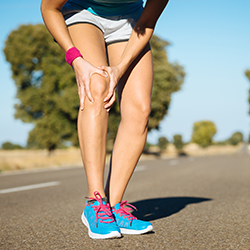
Six of The Most Common Injuries Seen in Runners
Posted on November 8, 2017
As runners and athletes, it is common to experience aches and pains. Here are the six most common injuries runners face and the fixes for them from Dr. Michael Ellman, sports medicine specialist!
- Iliotibial Band Syndrome
- Illiotibial Band Syndrome (ITBS) is a when the tendon tissue that runs along the outside of the hip, thigh, and knee becomes tight—this is a very common issue in runners and other athletes. ITBS is typically caused by muscle imbalances that stem from overuse or naturally tight IT bands. Identified by pain along the outside of the hip, thigh, and knee.
- The Fix: Rest, decrease activity and modify to focus on form and rebuilding weak or imbalanced muscles, and physical therapy to focus on stretching and strengthening exercises for the iliotibial band.
- Trochanteric Bursitis
- Trochanteric bursitis is Inflammation of the bursa, or fluid-filled sac, on the outside of the hip which causes pain with activities or when sleeping at night. Causes include a tight iliotibial band (IT band syndrome) repetitively rubbing against the bursa, direct injury or trauma to the outside of the hip, or an underlying tear of the tendons that attach to the outside of the hip bone. Identified by pain along the outside of the hip.
- The Fix: Rest, Activity Modification, Anti-inflammatories, and Physical therapy to focus on alleviating direct pressure over the bursa. Injections may also be beneficial to decrease inflammation and improve pain.
- Stress Fractures
- Stress fractures are regions of increased stress or inflammation in the bone. The inner portion of the bone is “fractured,” but the outer layer of the bone remains intact—for this reason they are typically diagnosed via MRI rather than x-ray. Stress fractures are usually caused by overuse or repetitive impact to a specific joint or bone and most commonly occur when volume of impact is too rapidly increased. Identified by pain that can be “pointed-to” that lasts for a long time and does not get better after warming-up.
- The Fix: Rest and avoid impact activities. Depending on where these occur, may require several weeks of crutches and non-weightbearing. When beginning new training, remember to increase volume slowly to allow your body to adjust without becoming injured.
- Cartilage & Meniscus Tears
- Cartilage and meniscus tears are damage to the lining of the knee joint (articular cartilage) or the shock absorbers of the knee (medial and lateral meniscus). They usually happen in cases of overuse, repetitive impact, or direct trauma to the knee.
- The Fix: In minor tears, trial of non-operative treatment with physical therapy, modification of activities, and possible injections. In the case of large or displaced tears, may require arthroscopic surgery to fix or remove the torn tissue.
- Muscle Strains & Tears (including groin)
- Muscle strains and tears are injuries to muscle or tendons in the quadriceps, groin, and hamstring or buttock region. They are most common in sports involving cutting, pivoting, or sprinting. Strains and tears are usually caused by eccentric “pull” (elongating) of muscle when attempting to contract muscle at same time.
- The Fix: RICE (rest, ice, compression, elevation), avoidance of running/sprinting/cutting/pivoting, and potentially limitation of weight-bearing depending on degree of injury. Large tendon tears may require surgical fixation.
- Runner’s Knee
- Runner’s knee is a mix of issues found in runners involving problems with the patella (kneecap) as it moves with knee motion. Also known as patellofemoral syndrome. This may include some combination of cartilage damage under the kneecap or issues with the track of the kneecap as it movies within its groove in the femur. Usually it is brought on by overuse with relative muscle imbalance of the hip muscles and quadriceps
- The Fix: Rest, avoidance of impact activities, and muscle strengthening in physical therapy.